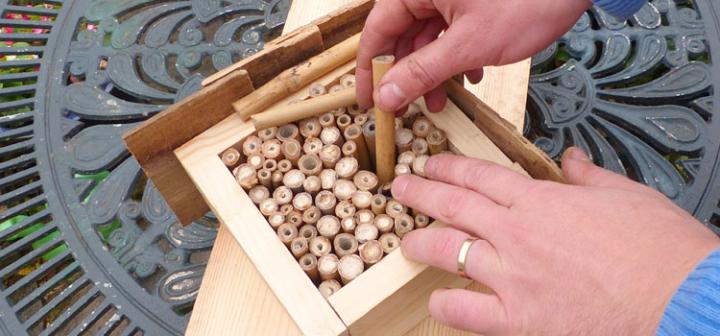Create Bug Hotels to Help Beneficial Insects Overwinter!
Make a bug hotel so that your insects can overwinter! Insect hotels give beneficial insects a safe, cozy home to shelter in over winter, so they’ll be right on hand to help fight pests and pollinate crops when the weather warms up next year. In this article (with video), we’ll how you how easy it is to make a bug hotel!
Not all insects should be considered pests. Beneficial insects are crucial to the success of fruits and vegetables. By building an insect hotel, you can encourage these helpful critters check in and take up residence in your garden forever! It’s a fun project for the whole family.
Beneficial insects are an essential part of any garden. They help us by eating pests and by pollinating crops but to to make sure there are lots of them in the garden in time for spring, they need some protection during the colder months.
Bug Hotel Designs
Bug hotels can be made from salvaged and natural materials such as prunings, sticks, straw, broken tiles, bricks and old pieces of wood. The secret lies in providing a variety of habitats to attract a variety of insects.
Bug hotels vary in size and complexity according to the space and time you have available to make one. The simplest hotels consist of a dry, sheltered space into which bedding materials are stuffed. More complicated hotels may be made up of different materials stacked together to draw in the widest range of insect guests. Old pallets can be very useful in this instance.
Bugs You Will Attract
Decaying logs will attract wood-boring beetles and centipedes, while bark is a must for woodlice and millipedes. Tempt in ground and rove beetles (which eat slug eggs) by packing in plenty of twigs and branches. Native (or solitary) bees, wasps and hoverflies love hollow stems, such as bamboo canes, while spiders will make their home in just about any dry nook or cranny. Ladybugs devour aphids and hibernate in hollow stems and leaf litter.
How to make a bug hotel
Here’s how to make a simple hanging bug hotel suitable for solitary bees, ladybugs and hoverflies.
What you’ll need
To make your hotel you will need a plank of wood 120cm, or four feet long, some thin shingles to serve as roof tiles, some strong string, plus a plank of wood wide enough to form a back plate to your hotel. To avoid harm to the insects, use untreated wood.
To fill the hotel you’ll need a selection of hollow stems – bamboo canes are ideal for this. You’ll also need a drill, a screwdriver and some screws, a hammer and tacks and some pruners.
Build the Hotel
Begin by making the walls to your hotel. Cut the long plank to four equal lengths of 30cm or a foot. Attach them to each other using the screws. You may need to make a pilot hole for each screw before securing it into place. Here’s the finished structure.
With the walls complete, attach the back plate to create a snug seal. You can mark the footprint of the walls onto the plate as a guide before screwing it into position.
Now for the roof shingles. Use the tacks to simply hammer these into place, overlapping the shingles to help rain to run off and keep inside of the hotel dry. If you wish, you can now paint the hotel with a natural, non-toxic paint or wood stain to give a colorful finish. Allow the paint to dry before continuing.

Add the Bedding
It’s now time for the bedding materials. Cut the stems or bamboo to length. The bamboo should sit flush with the walls of the hotel like this. Pack them into place to give a good, solid finish. Drill two holes into the top of the back plate then thread some string through. Tie the ends into a knot then hang your hotel up in a dry, sheltered place in full sun or dappled shade – in among trees and shrubs is ideal, or you could hammer your hotel into the eaves of a garden shed or outbuilding.
A simple alternative
A simple alternative to a bamboo cane hotel is to drill lots of holes into a solid block of wood. Avoid drilling all the way through the block. You can also add a shingle roof for a decorative finish. Attach a vine eye, thread through your string, then hang up into position.
As you can see, it’s very easy to make a safe and secure habitat for beneficial bugs to thrive. How do you attract beneficial insects into your garden? Do drop us a comment below and let us know.
If you love growing your own food, why not take a look at our online Almanac Garden Planner here: https://gardenplanner.almanac.com
ADVERTISEMENT
I live in the US Virgin Islands and we have some of the same species (although they may be a sub-species) of the beneficial insects that use the "bug hotels" up north. We are considering using a "bug hotel" even though we do not have a winter because habitat loss is making it harder for them to find nesting locations. Can you think of any reasons why this may be a bad idea?
How do you know that bad bugs will not shelter in here?
It’s always a possibility that some bad bugs will seek shelter in a bug hotel, but pests generally shelter near the crops or other plants that they affect. So, the benefits of a bug hotel far outweigh the potential downsides!
Do these bug hotels need to be cleaned seasonally?
It’s not necessary to clean out a bug hotel each season, since insects will use it to overwinter in and you may inadvertently remove hibernating residents by cleaning it out. However, after a few years, the nesting materials may get used up; at this point, you can replace used nesting material with new ones.
Thank you for your video! Do you recommend that the Bug Hotel be rather close to the garden or far away? What would be an ideal distance, in other words?
Have the bug hotel as close to your garden as you can. It will be full of beneficial insects, and the closer they are to the plants you are growing, the more of a beneficial effect they will have - whether that's pollinating plants or predating on pests.
Somewhere relatively close to the garden is good since you want beneficial insects to control the bugs in your garden but to be honest they’ll probably find the garden anyway so it’s not too critical. A sheltered position is best.
Thank you for making your video on how to build a bug hotel for beneficial insects. As a plant scientist, I can't believe I have never even heard of the idea! I am always trying to give bugs a good name, so I am excited to share this project with my 4th grade students. This is a great project to physically show them how plants and bugs work together in the ecosystem. Plus, every child will enjoy putting together a creative, attractive garden piece!
Thanks again, and I look forward to watching more of your videos. I am an avid gardener and I love plants!









